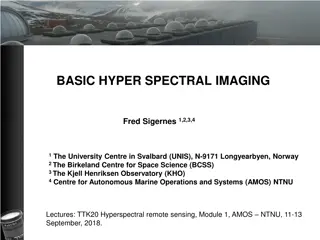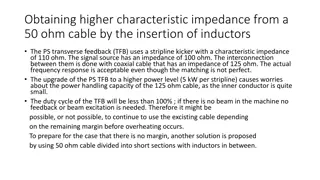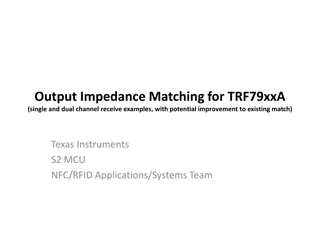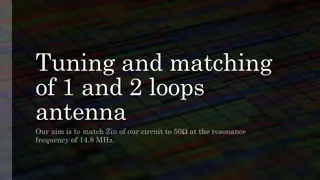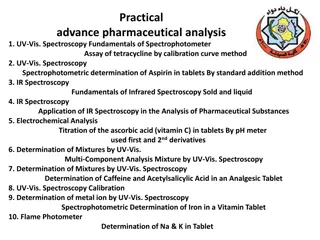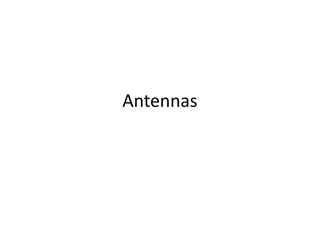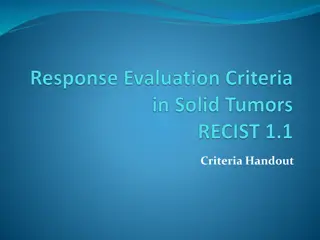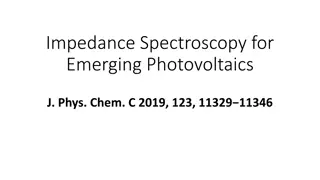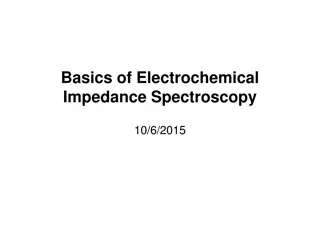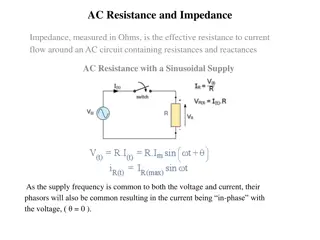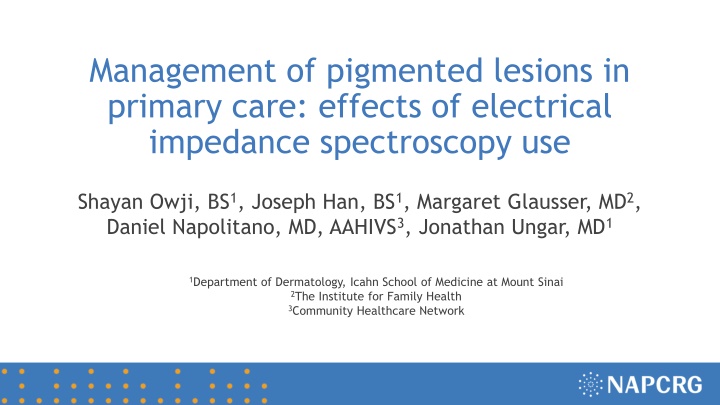
Effects of Electrical Impedance Spectroscopy on Pigmented Lesion Management
This study explores the impact of using Electrical Impedance Spectroscopy (EIS) alongside visual inspection in primary care for managing pigmented skin lesions. Findings show improved diagnostic accuracy and suggest potential benefits for patient care, reducing morbidity and mortality risks associated with melanoma detection.
Download Presentation

Please find below an Image/Link to download the presentation.
The content on the website is provided AS IS for your information and personal use only. It may not be sold, licensed, or shared on other websites without obtaining consent from the author. If you encounter any issues during the download, it is possible that the publisher has removed the file from their server.
You are allowed to download the files provided on this website for personal or commercial use, subject to the condition that they are used lawfully. All files are the property of their respective owners.
The content on the website is provided AS IS for your information and personal use only. It may not be sold, licensed, or shared on other websites without obtaining consent from the author.
E N D
Presentation Transcript
Management of pigmented lesions in primary care: effects of electrical impedance spectroscopy use Shayan Owji, BS1, Joseph Han, BS1, Margaret Glausser, MD2, Daniel Napolitano, MD, AAHIVS3, Jonathan Ungar, MD1 1Department of Dermatology, Icahn School of Medicine at Mount Sinai 2The Institute for Family Health 3Community Healthcare Network
The Research Question What effect does electrical impedance spectroscopy (EIS) use have on primary care providers management decisions for pigmented skin lesions?
Research Design and Method Online survey elicited biopsy/referral decisions for 12 melanocytic lesions (incl. melanomas, severely dysplastic nevi, mild-moderate dysplastic nevi) from primary care physicians and nurse practitioners Lesions first presented as clinical image (with biopsy/referral selection) and again as clinical image + EIS score (with biopsy/referral selection) Sensitivity/specificity of biopsy/referral decisions for melanoma & severely dysplastic nevi were compared for visual examination alone vs. concurrent visual + EIS evaluation
What the Research Found 1354 clinical decisions made in total by 61 participants (44 physicians, 17 NPs) Overall sensitivity: Visual inspection + EIS > visual inspection (90% vs. 69%; P < 0.001) Overall specificity: Visual inspection + EIS > visual evaluation (73% vs. 44%; P < 0.001) Visual Inspection Sens (%) Visual Inspection and EIS Sens(%) TN (n) Demographic P-value, Sens P-value, Spec TP (n) FN (n) TN (n) FP (n) Spec (%) TP (n) FN (n) FP (n) Spec (%) Occupation Physicians 147 50 74.6 131 151 46.5 181 16 91.9 209 73 74.1 <.001 <.001 Nurse 46 36 56.1 44 72 37.9 70 12 85.4 80 36 69.0 <.001 <.001 practitioners Years in practice 0-5 64 33 66.0 63 77 45.0 89 8 91.8 102 38 72.9 <.001 <.001 6-14 82 40 67.2 74 100 42.5 106 16 86.9 123 51 70.7 <.001 <.001 15+ 48 12 80.0 38 46 45.2 56 4 93.3 64 20 76.2 .011 <.001 Overall 193 86 69.2 175 223 44.0 251 28 90.0 289 109 72.6 <.001 <.001
What this means for Clinical Practice Overall, this study suggests that diagnostic accuracy for pigmented skin lesions by primary care providers may be improved with adjunctive use of EIS with visual inspection This would ultimately improve patient care and reduce the morbidity and mortality of a melanoma diagnosis




